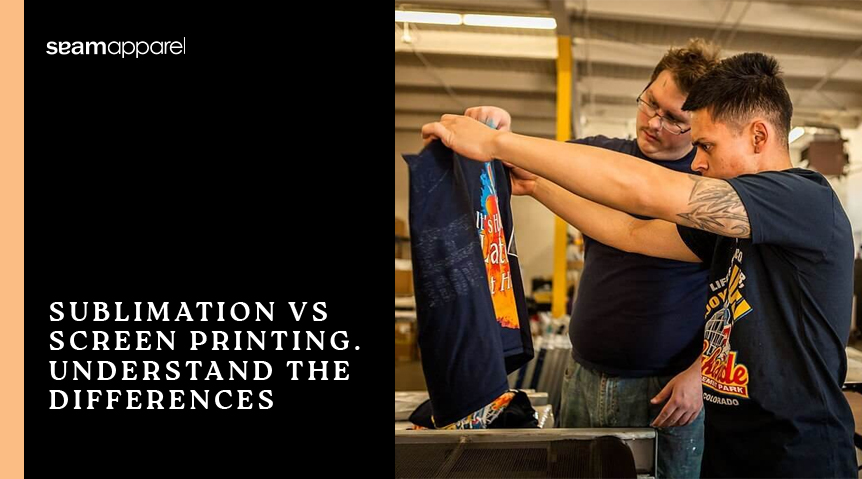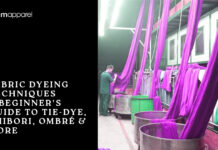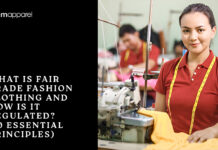Are you interested in modifying your t-shirt design ideas and making them look even better by personalizing them? Screen printing or sublimation is at your service!
What is the difference between screen printing and sublimation? Sublimation and screen printing are two different techniques for creating high-quality and long-lasting prints. The first, sublimation printing, uses chemical processes to link with the polyester filaments, consuming less time.
Sublimation print vs. screen print, on the other hand, employs a heat source, thick inks, and stencils. thus occupying much more time.
When practicing printing, especially on ceramics or fabrics, people use two types of prints commonly; silk screen printing vs. sublimation. Both of them lead to pleasing results. Want to know more about the Screen printing vs. sublimation debate? Continue reading with us.
Sublimation Printing vs. Screen Printing – Main Methods of Printing
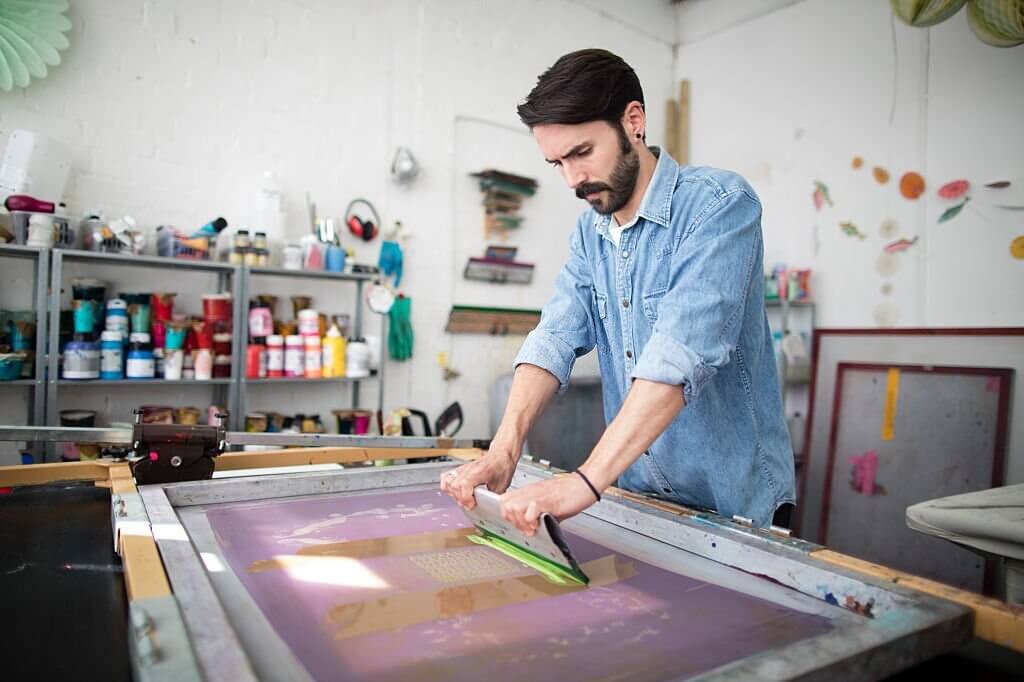

Screen Printing
-
What is Screen Printing?
This method is also known as Silk Screening or Serigraphy. It is amongst the oldest methods of printed art. It is one of the most popular ways to customize textiles, and people have used this form for ages. Also, it creates a heavy and upraised design on the exterior of the ceramic.
-
History of Screen Printing
Screen Printing remained a simple process in the 19th CE. In the 20th CE, people started to use machines for printing posters, then using fabrics over wooden frames. At first, it was a bridge between the automated printing process and hand-fed production.
-
Screen Printing in the Present
Now Screen Printing is a very sophisticated process that uses a combination of inks, fabrics, and computers to design logos or anything like that. With the help of Silk Screening, one could print the layers image on any and every surface like leather, glass, wood, plastic, paper, fabric, or card.
-
How does Screen Printing work?
Firstly, the printer uses a stencil of the chosen image and places it on the substrate. Later, one pours the ink onto the stencil and evenly spreads it all over the stencil. Ink is applied with the help of cotton to force ink through the screen and onto the textile. From the pours, the ink enters the fabric.
-
Why use Screen Printing?
People practice Silk Screening because it produces vibrant colors on dark ceramics too. The ink stays in the layers of the fabric, giving it a good quality. Moreover, people prefer using this method as one can use the same stencil repeatedly, which can help reproduce the same design.
Thus, it helps make several copies of the same fabric. It makes Screen Printing an efficient technique to help create large batches of customized garments for sports teams or other purposes. Also, it allows for more concentrated coloring.
Step-By-Step Process of Screen Printing
-
- Step 1: Design creation
- Step 2: Preparing the Screen
- Step 3: Exposing the mixture
- Step 4: Stencil creating by washing off the emulsion
- Step 5: Preparing the item for the printing process
- Step 6: Pressing the ink through the screen against the fabric
- Step 7: The ceramic is dried, finished, and checked
Setting up a screen print needs loads of expertise and time. However, you can use the screen many times after you have used it once. One can keep using the printing screens as many times to make more of the same designed articles.
Although Screen Printing is a traditional method, it is still widely practiced. It uses screens to get the design onto the fabric. Thus, it is ideal for easy and simple patterns. Also, it is easy to screen-print large volumes of shirts once the initial setup is complete.
In Screen Printing, the design becomes the top layer while screening each color individually. One can make designs by using multiple colors or just one shade of ink.
Goods Needed For Screen Printing
- Transfer Tape
- Heat Press
- Screen Printing with Vinyl Starter Kit
- Cricut Maker
- Painter’s Tape
Related: How to Start a Screen Printing Business To Scale Your Small Business.
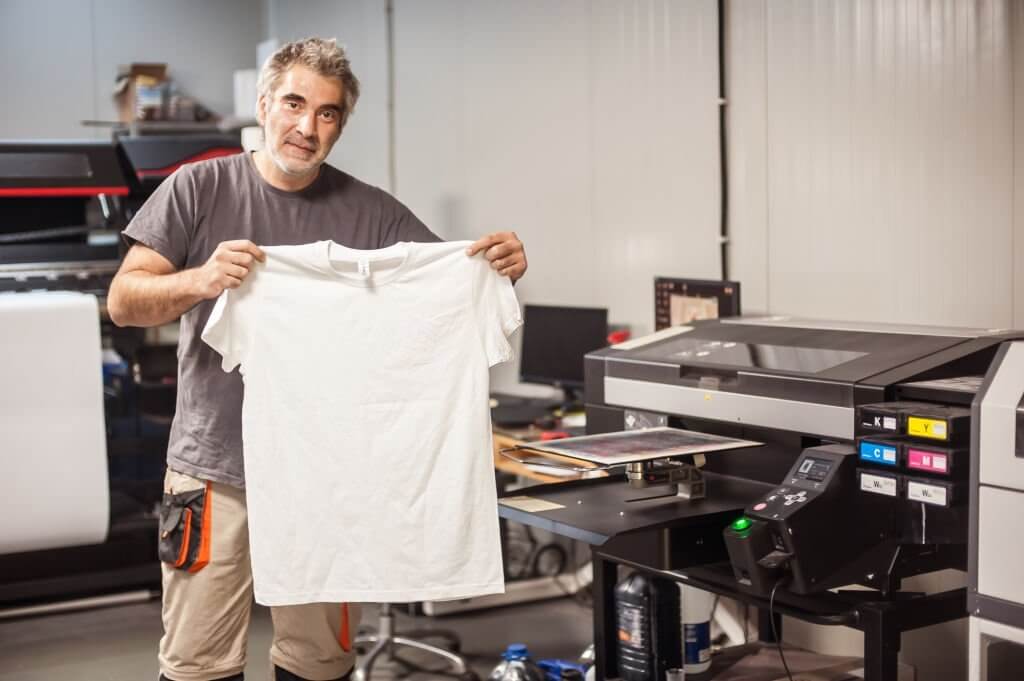

Sublimation Printing
-
What is Sublimation Printing?
Businesses widely use sublimation to transfer their logos or pictures onto anything like cell phone cases, mugs, or t-shirt business for sublimation. It is an environmentally-friendly and easy transfer process that does not add layers on top. Also, it is cheaper and lasts relatively longer without fading, peeling, or cracking.
Related: What is Sublimation Printing? How Does It Work?
-
History of Sublimation Printing
In ancient times, people used stamps to print images on clothes. People used small clay or metal stamps and seals for decoration to print identical pictures.
-
Sublimation in the present
Later on, Dye-Sublimation Machines came into play. People used these machines to transfer dye onto materials such as fabric, plastic, or paper with the help of heat. Thanks to printing, it is now possible to print magazines, newspapers, and books in bulk to spread information and increase literacy.
-
How does Sublimation Printing work?
Sublimation dyes transmit onto a transfer paper and then onto the polyester material, such as a t-shirt, via heat transfer and pressure. The ink moves from the transfer paper to sit on the fabric. Thus, when the ink cools down, it appears glossy and becomes a permanent part of the garment.
Is sublimation better than vinyl? Sublimation printing ideas are a fantastic choice if your company concentrates on or is primarily focused on producing white and light-colored polyester clothing. Your prints will be extremely durable and washable, even with the lightest hand. Heat transfer paper is your best bet, nevertheless, if you want to print on any color or kind of material.
Step-By-Step Process of Sublimation Printing
- Step 1: Design drafting
- Step 2: Printing the pattern onto the transfer paper with sublimation inks
- Step 3: The Sublimation Process
- Step 4: Sewing and cutting of the sublimated fabric
- Step 5: Complete the garments created
- Types of Sublimation Transfers
Calendar Heat Press
When sublimating on relatively softer and larger surfaces such as fabric, Calendar Heat Press will be the way to go. It is a large press that accommodates printing on banners and clothes.
Flatbed Heat Press
People prefer it when sublimating on firm surfaces, such as home décor or floor tiles. It suits printing on clothes and is flexible.
3D Vacuum Heat Press
When dealing with small objects with a range of shapes, someone may recommend you a 3D Vacuum Heat Press. This machine especially helps to sublimate surfaces that are not flat.
Small Heat Press
People will recommend it when sublimating small items, such as creating a pattern on kitchenware. It takes up a small amount of space and is helpful for numerous things.
Sublimation Printing Materials
Few polyester-coated materials ask for different strategies when using the Sublimation Printing method;
- Polymer (Teflon and Nylon)
- Ceramic (Vases, mugs, tiles)
- Fabric (Custom tents, tablecloths, t-shirts, dresses)
Materials Needed For Sublimation Printing
- Heat Press
- Hiipoo Sublimation Ink
- Epson ET-3760 Printer
- Sublimation Paper
- Lint Roller
- Heat Resistant Tape
- Teflon Sheet (Butcher Paper)
Sublimation or Screen Printing – Pros and Cons
Sublimation
- Advantages of Sublimation
- Sublimation Printing helps print everything all together in one piece without paying extra for the different designs or colors.
- The clothing is less likely to peel, fade, or chip as the ink becomes a part of the fabric. That makes the garment more durable, cleaner, and lighter.
- While using sublimation, one can use as many colors and designs as wanted. There is no limit to the number of colors or the type of patterns. Also, the cost remains unchanged whether producing ten units or a hundred.
- Without paying for the setup costs again, one can print the same design or logo again on another garment.
- Sublimation Printing is a cleaner and better printing technique as it allows for a lesser mess, unlike Screen Printing.
- Disadvantages of Sublimation Printing
- Sublimation Printing works best on light or white polyester fabrics and would fail to work on dark colors as it uses transparent inks.
- It works well only on polymer-coated or polyester surfaces. And not on fabrics that have less than two-thirds of polyester.
- The heat presses or sublimation printers are costly. The one who has to begin with sublimation printing services has to invest a heavy amount of money for its setup costs.
- Benefits of Screen Printing
- An individual willing to set up Screen Printing can select from a diverse range of inks that will help you produce special effects. With the correct type of ink, one can create foil or 3D designs.
- Screen Printing can be done on nearly any textile material as long as it has a flat surface.
- Screen Printing is cost-effective for high volumes of fabrics of the same design. People willing to start screen printing services or sublimation at home can afford to buy them.
- There are lesser details. Hence, making Screen Printing an excellent selection for graphics, names, or logos. However, it may not be suitable for intricate designs or photography.
- The designs produced by Screen Printing are highly durable compared to Digital Printing Designs. Also, Screen Printed Designs can withstand wear and sunlight.
- Drawbacks of Screen Printing
- If an individual wants to use multiple colors, they will have to add each color separately. Therefore, increasing the production time and adding up to costs.
- When doing Screen Printing, one can use a limited amount of colors. Thus, resulting in relatively simple designs.
- If you are making a single t-shirt, it may cost more, as screen printing is a lengthy process. Also, adding up to the costs along with consuming more time too.
- Screen Printing cannot add details to the designs. So, people who want to have technicalities prefer other printing methods.
- The design may fade, peel, or crack over time, not making it a priority for people who want long-term prints.
Screen Print or Sublimation – Differences
- The fabric absorbs the ink, making it a permanent part of itself in the process of Sublimation.
- Silk Screening involves squeegee, ink, stencils, and screens
- Sublimation requires sublimation paper, a heat press, a computer, and a sublimation printer for shirts.
- Serigraph Printing occupies more time to complete the production than Sublimation.
- Sublimation saves time and is easier to print.
- Screen Printing can be messier than Sublimation and may be erroneous.
- One can use a range of colors and patterns while sublimating.
- Serigraphy is effective for batch production, and Sublimation Printing is better for custom orders.
- Sublimation is more durable than screen printing and is unlikely to crack, fade, or peel.
- One can Screen Print on any fabric material.
Screen Printing or Sublimation – FAQs
Sublimation or Screen Printing: Which is Better?
When considering fabric customization, it is impossible to select the best from the two printing techniques sublimation, and screen printing. If you want to proceed with higher volumes of fabric customization on a tight budget, screen printing would be the best option. However, if you have some extra money and want realistic patterns, it would be better for you to go for sublimation printing.
Is sublimation printing better than screen printing?
Sublimation printing and screen printing both create high-quality, unique designs on fabric. If you cannot decide between the two, keep reading below for a quick debate on which is better: sublimation or screen printing.
Sublimation printing easily creates multi-color design prints and is highly durable because the dye becomes a part of the fabric. Also, it does not fade, crack, or peel with time and creates vibrant designs on flat fabric. However, it only works on polyester and looks best on white or light surfaces.
On the other hand, silk screening or screen printing creates a unique textured design. The design stays durable after some washes, yet it may crack eventually. It is economical to use screen printing when you have bulk orders, as its setup costs are relatively high. It would also work best with fewer colors.
Final Words
The difference between screen printing and sublimation is that both printing techniques have their benefits and drawbacks. However, it is important to remember that businesses use both methods depending on the work that needs to be done. Clothing manufacturers not only use the two techniques described in the article above but also use several other printing methods for different printing purposes.

